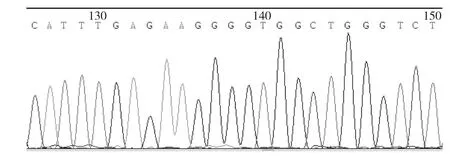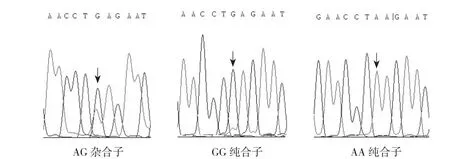西门塔尔牛HDAC1基因SNP检测及其与屠宰性状的相关性分析
2016-07-13施巧婷石德顺徐照学李湘萍
杨 颖,施巧婷,陆 江,石德顺,徐照学,李湘萍
(1.广西大学动物科学技术学院,广西 南宁 530004;2.河南省农科院畜牧研究所,河南 郑州 476800;3.湖北医药学院麻醉学研究所/湖北医药学院附属太和医院,湖北 十堰 442000)
西门塔尔牛HDAC1基因SNP检测及其与屠宰性状的相关性分析
杨 颖1,施巧婷2,陆 江3,石德顺1,徐照学2,李湘萍1
(1.广西大学动物科学技术学院,广西 南宁 530004;2.河南省农科院畜牧研究所,河南 郑州 476800;3.湖北医药学院麻醉学研究所/湖北医药学院附属太和医院,湖北 十堰 442000)
摘 要:通过对37头西门塔尔牛第2条染色体上的组蛋白去乙酰化酶1基因(HDAC1)的Intron 4-Intron 5、Intron 10-Intron 11和3′非翻译区进行克隆和序列分析,采用SSCP分析方法和PCR产物直接测序的方法,判定SNP基因型,并分析SNP基因型与屠宰性状的相关性。结果发现,西门塔尔牛的HDAC1基因Intron 4-Intron 5以及3′端非翻译区没有突变位点;在HDAC1基因Intron 10-Intron 11区存在1个突变位点,该突变位点位于测序结果的110 bp处,为A/G突变,其中AG杂合子频率(48.6%)与纯合子GG/AA频率(51.4%)大致相当,但G等位基因频率(62%)远大于A等位基因出现的频率(38%)。经在37头西门塔尔牛屠宰样品中的背膘厚屠宰性状比较,AA基因型个体的背膘厚显著低于GG和AG型个体,提示G等位基因对生长具有正效应。
关键词:西门塔尔牛;组蛋白去乙酰化酶1;单核苷酸多态性;屠宰性状
在肉牛新品系的培育及品种改良试验过程中,合理改善生长环境、饲养条件,可以改善肉牛胴体和肉质性状,提高养牛业的经济效益。但肉牛本身的遗传基因特性同样会对肉牛的生长状况、屠宰性状等产生显著影响,例如基因突变、遗传变异等[1]。组蛋白去乙酰化酶(HDAC)与基因的转录活性有着密切关系,转录活跃区的核小体组蛋白呈高度乙酰化,而不活跃的染色质呈去乙酰化状态。组蛋白去乙酰化在基因转录、信号转导、个体发育、细胞增殖和分化中至关重要[2-6]。因此,我们试验分析了西门塔尔牛HDAC1基因的核苷酸碱基多态性与屠宰特性之间的相关性,以期为西门塔尔牛的新品系的培育及品种改良等提供遗传参考[7-11]。
1 材料与方法
1.1 试验材料
1.1.1 试验样品 37头西门塔尔牛(北京金维畜牧有限公司提供),颈静脉采血,加入抗凝剂抗凝,低温运回实验室,-80℃保存。
1.1.2 常用试剂 DNA 抽提液:0.1 mol/L EDTA (pH8.0),10 mmol/L Tris·HCl(pH8.0),0.5%SDS,20 μg/mL 胰 RNA 酶,室温保存。聚丙烯酰胺凝胶(30%,N,N′-甲叉双丙烯酰胺∶丙烯酰胺=1∶29):在1 L水中加入N,N′-甲叉双丙烯酰胺20 g、丙烯酰胺580 g,定容至2 L。变性缓冲液:取二甲苯氰2.5 mg、0.01 mol/L EDTA 200 μL、溴酚兰2.5 mg加入到9.8 mL去离子甲酰胺溶液中,最后加入甘油200 μL,4℃保存。实验所用其他试剂盒缓冲液例如ACD抗凝剂、磷酸盐缓冲溶液、Tris·HCl、TBE缓冲液、70%乙醇、TAE缓冲液等均根据分子克隆实验指南配制。
1.1.3 主要仪器设备 PCR仪与冷冻高速离心机(Eppendorf,德国),凝胶成像仪(Syiglhr/1439,英国)。
1.2 试验方法
1.2.1 血液基因组DNA的提取 基因组提取具体操作步骤见《分子克隆试验指南(第3版)》。提取的基因组DNA用分光光度计测定浓度,琼脂糖凝胶电泳检测后-20℃保存。
1.2.2 引物设计 试验所用的PCR引物(表1)使用Oligo6.0根据牛的HDAC1基因组序列(GenBank:AC_000159.1)设计,由上海生工公司合成。

表1 引物序列
1.2.3 SSCP-PCR PCR扩增体系(12.75 μL):ddH2O 5.50 μL、上游引物(10 pmol/μL)0.25 μL、下游引物(10 pmol/μL)0.25 μL、DNA 模板(500 ng/μL)0.50 μL、2×Taq Master Mix 6.25 μL。PCR反应程序:94℃预变性3 min,95℃变性30 s,退火温度(表1)下退火30 s,72℃延伸30 s,30~45个循环;最后72℃延伸5 min。
PCR产物加入变性缓冲液,经高温变性后,于10%非变性聚丙烯酰胺凝胶中电泳,结果使用0.2%硝酸银染色法染色观察。
1.2.4 PCR产物回收、克隆、测序 PCR扩增产物纯化回收按照琼脂糖凝胶纯化回收试剂盒(北京艾德莱生物科技有限公司)说明书进行操作。将回收PCR片段直接送往测序公司进行测序。
1.3 数据处理
DNA序列处理采用软件Primer5、DNAstar、Clustalx1.83、Chromas以及在线软件http://www. ebi.ac.uk/Tools/msa/clustalw2/。参照文献[1-2]所述方法,通过SAS统计软件(Version 8.0)进行数据分析。具体模型为:

式中,Y为性状表型值,μ为平均值,G为基因型效应(包括基因加性效应和显性效应),b为屠宰体重的回归系数,X为屠宰体重,e为残差。
2 结果与分析
2.1 西门塔尔牛HDAC1 Intron 4-Intron 5多态性
西门塔尔牛HDAC1基因Intron 4-Intron 5经过PCR-SSCP分析后未检测到核苷酸多态性(图1)。PCR产物纯化后进行测序,采用Ebi在线软件比对分析,结果证实在该西门塔尔牛群体中HDAC1 Intron 4-Intron 5没有核苷酸多态位点(图2)。

图1 西门塔尔牛HDAC1 Intron 4-Intron 5 PCR-SSCP结果

图2 混合DNA西门塔尔牛HDAC1 Intron 4-Intron 5测序峰
2.2 西门塔尔牛HDAC1基因3′非翻译区多态性
通过PCR产物直接测序分析西门塔尔牛HDAC1 3′非翻译区368 bp片段,经测序结果的多重比较,未发现该片段具有单核苷酸多态性。部分测序峰见图3。

图3 混合DNA西门塔尔牛HDAC1 3′非翻译区测序结果
2.3 西门塔尔牛HDAC1 Intron 10-Intron 11多态性
西门塔尔牛HDAC1 Intron 10-Intron 11经PCR扩增,276 bp产物回收后直接测序检测该片段的核苷酸多态性。测序结果经多重比较发现,在这个西门塔尔牛群体中,HDAC1基因Intron 10-Intron 11 第110核苷处有1个多态性位点,为A/G突变。结合测序峰图判断基因型分别为GG纯合子、AA纯合子和AG杂合子3种基因型 (图4)。
2.4 西门塔尔牛HDAC1 Intron 10-Intron 11 A/G突变基因型频率与基因频率

图4 西门塔尔牛HDAC1 Intron10-Intron11多态位点基因型测序结果
检测该西门塔尔牛群体样本HDAC1 Intron 10-Intron 11的第110 bp处的A/G多态性位点的基因型频率和基因频率发现,该群体中GG基因型占37.8%(14/37),AG基因型占48.6%(18/37),AA基因型占13.5%(5/37),AG杂合子频率大于纯合子频率;G等位基因频率为62%,大于A等位基因频率38%。
2.5 西门塔尔牛HDAC1 Intron 10-Intron 11多态性位点与屠宰性状关联性分析
应用SAS软件,对西门塔尔牛HDAC1 Intron 10-Intron 11 A/G多态性位点的不同基因型与胴体重、大理石花纹等屠宰性状进行关联分析和遗传效应估计。结果表明,AA基因型个体的背膘厚显著低于GG和AG型个体,A基因加性效应对西门塔尔牛背膘厚屠宰指标影响显著(表2)。

表2 西门塔尔牛HDAC1 Intron 10-Intron 11与屠宰性状的关联性分析结果
3 讨论
西门塔尔牛是我国引进的乳肉兼用型的典型品种,兼具奶牛和肉牛特点。本试验在西门塔尔牛的HDAC1基因Intron 4-Intron 5、3′UTR片段中未发现SNP突变位点,在Intron 10-Intron 11的110 bp处发现存在A/G突变位点,为A/G突变,其中AG杂合子基因型频率(48.6%)与纯合子GG/AA基因型频率(51.4%)大致相当,但是G核苷等位基因频率(62%)较A核苷等位基因频率(38%)明显占优势。将该核苷多态性与屠宰经济性状进行关联分析发现,具有G核苷等位基因(即AG基因型或GG基因型)的西门塔尔牛其屠宰性状中的背膘厚指数要显著优于AA基因型纯合的个体,可能HDAC1基因该位点的G等位基因为候选的优良核苷基因[2-4]。这也可能是西门塔尔牛群体的背膘厚屠宰性状存在差异的原因之一[7-10]。
屠宰性状数据一般通过屠宰后测定获得,用总体重、胴体重、大理石花纹、眼肌(实测)、眼肌(机测)、背膘厚(实测)、背膘厚(机测)、肌间脂肪(机测)等指标作为后备牛选择的重要依据[12-14]。据报道,HDAC1与猪的主要分割性状(颊重、后腿重、肩部脂肪重)有显著性联系。HDAC1基因的多态性影响了猪的生长速度和生长性能指数、背膘厚和瘦肉率等性状[15]。
本试验在西门塔尔牛的屠宰性状中,HDAC1基因Intron10-Intron11处,背膘厚(实测)性状AA基因型个体均值分别与GG和AG基因型个体均值存在显著差异;对加性效应而言,背膘厚AA型均值低于GG和AG型,等位基因G对生长具有正效应[2,16-17]。
在西门塔尔牛群体中,AG或GG基因型个体可以作为背膘厚(实测)的一个主要候选基因或分子标记,选择AG或GG基因型个体可使群体向背膘加厚、肉质性状良好的方向进展。同时,本试验从基因突变水平证实了HDAC1基因对西门塔尔牛的背膘厚等屠宰性状的显著影响,为西门塔尔牛育种工作中良好经济性状的选择增加了一个候选参考。
肉牛分子育种研究群体不稳定,没有固定的试验群体,个体流动性较大,很多是农民饲养的个体资料,追踪验证困难。为了充分说明候选基因SNP多态性与生长性状、屠宰性状等的相关性,必须加大样本量进一步研究[7-11]。我国没有较大的、规模化的肉牛育种场,样本量的获取很受限制,建议建立稳定的育种核心群体。
参考文献:
[1] Barendse W,Bunch R J,Thomas M B,et al. A splice site single nucleotide polymorphism of the fatty acid binding protein 4 gene appears to be associated with intramuscular fat deposition in longissimus muscle in Australian cattle[J]. Anim Genet,2009,40(5):770-773.
[2] Ma P,Schultz R M. Histone deacetylase 1(HDAC1)regulates histone acetylation,development,and gene expression in preimplantation mouse embryos[J]. Dev Biol,2008,319(1):110-120.
[3] Shen Q,Yao Q,Sun J,et al. Downregulation of histone deacetylase 1 by microRNA-520h contributes to the chemotherapeutic effect of doxorubicin[J]. FEBS Lett,2014,588(1):184-191.
[4] Nohata N,Hanazawa T,Kinoshita T,et al. Tumoursuppressive microRNA-874 contributes to cell proliferation through targeting of histone deacetylase 1 in head and neck squamous cell carcinoma[J]. Br J Cancer,2013,108(8):1648-1658.
[5] Wang A G,Kim S U,Lee S H,et al. Histone deacetylase 1 contributes to cell cycle and apoptosis [J]. Biol Pharm Bull,2005,28(10):1966-1970.
[6] Boffa L C,Gershey E L,Vidali G. Changes of the histone deacetylase activity during chick embryo muscle development[J]. Biochim Biophys Acta,1971,254(1):135-143.
[7] Kebir O,Chaumette B,Fatjo-Vilas M,et al. Familybased association study of common variants,rare mutation study and epistatic interaction detection in HDAC genes in schizophrenia[J]. Schizophr Res,2014,160(1-3):97-103.
[8] Zeng Z,Liao R,Yao Z,et al. Three single nucleotide variants of the HDAC gene are associated with type 2 diabetes mellitus in a Chinese population:a community-based case-control study[J]. Gene,2014,533(1):427-433.
[9] Vanajothi R,Rajamanikandan S,Sudha A,et al. Structural and functional analysis of KIT gene encoding receptor tyrosine kinase and its interaction with sunitinib and HDAC inhibitors:an in silico approach[J]. Pak J Biol Sci,2012,15(3):121-131.
[10] Dransfeld C L,Schaich M,Ho A D,et al. Class I HDAC SNP analysis in healthy donors compared to AML patients[J]. Leukemia,2007,21(7):1587-1590.
[11] Kim M H,Kim S H,Kim Y K,et al. A polymorphism in the histone deacetylase 1 gene is associated with the response to corticosteroids in asthmatics[J]. Korean J Intern Med,2013,28(6):708-714.
[12] Inoue K,Honda T,Oyama K. Genetic relationships between internal diseases diagnosed at slaughter and carcass traits in Japanese Black cattle[J]. J Anim Sci,2015,93(6):2714-2721.
[13] Santana M L,Jr.,Eler J P,Bignardi A B,et al. Multitrait linear reaction norm model to describe the pattern of phenotypic expression of some economic traits in beef cattle across a range of environments[J]. J Appl Genet,2015,56(2):219-229.
[14] Martelli G,Nannoni E,Grandi M,et al. Growth parameters,behavior,and meat and ham quality of heavy pigs subjected to photoperiods of different duration[J]. J Anim Sci,2015,93(2):758-766.
[15] Lebret B,Ecolan P,Bonhomme N,et al. Influence of production system in local and conventional pig breeds on stress indicators at slaughter,muscle and meat traits and pork eating quality[J]. Animal,2015,9(8):1404-1413.
[16] Legartova S,Stixova L,Strnad H,et al. Basic nuclear processes affected by histone acetyltransferases and histone deacetylase inhibitors[J]. Epigenomics,2013,5(4):379-396.
[17] Licciardi P V,Ververis K,Karagiannis T C. Histone deacetylase inhibition and dietary short-chain Fatty acids[J]. ISRN Allergy,2011,2011:869647.
(责任编辑 崔建勋)
Detection of gene HDAC1 SNP and its relationship with slaughtering traits in Simmental cattle
YANG Ying1,SHI Qiao-ting2,LU Jiang3,SHI De-shun1,XU Zhao-xue2,LI Xiang-ping1
(1. College of Animal Science and Techonlogy,Guangxi University,Nanning 530004,China;2. Livestock Breeding Research Institute,Henan Academy of Agricultural Science,Zhengzhou 476800,China;3.Anesthesia Research Institute,Hubei University of Medicine / Taihe Hospital of Affiliated of Hubei University of Medicine,Shiyan 442000,China)
Abstract:In this study,we cloned,sequenced and analyzed the regions of Intron 4-Intron 5,Intron 10-Intron 11 and 3'-non of gene Histone deacetylase 1 (HDAC1) on the second chromosomes in 37 Simmental cattles. By the methods of PCR-SSCP and sequencing analysis,we tried to judge and determine their SNP genotypes,and explore the relationship between SNP genotypes and slaughter traits in Simmental cattle. The results indicated that,there was no mutation on the regions of Intron 4-Intron 5 and 3'-non-translation of gene HDAC1 in Simmental cattle,but there was one mutation in the region of Intron 10-Intron 11 of gene HDAC1,and it located on the 110 bp polymorphism site of PCR sequencing result,it was a A/G mutation,the frequency of allele G (62%) was more than allele A(38%). By comparison and analysis,it might be co-related between different allele A/G genotype on region of Intron 10-Intron 11 and backfat thickness (measured) of slaughtering traits of Simmental cattle. There was significantly lower backfat thickness (measured) of slaughtering traits in genotype of AA than that in genotype of GA or GG. According to the results,in this 110 bp location of region Intron 10-Intron 11 of gene HDAC1,allele G may perform a positive effect on the backfat thickness (measured) of Slaughtering traits in simmental cattle.
Key words:Simmental cattle;histone deacetylase 1;single nucleotide polymorphism;slaughtering traits
中图分类号:S813.1
文献标识码:A
文章编号:1004-874X(2016)02-0128-05
收稿日期:2015-06-11
基金项目:国家肉牛牦牛产业技术体系(CARS-38);教育部国家级大学生创新创业训练计划项目(201210929004);湖北医药学院自然科学研究基金(2011QDZR-2);湖北医药学院2015年学科建设项目(学科英才);十堰市科学技术研究与开发项目(14Y13)
作者简介:杨颖(1983-),女,硕士,实验师,E-mail:YangYing_1983@126.com
通讯作者:李湘萍(1966-),女,博士,教授,E-mail:190139129@qq.com
